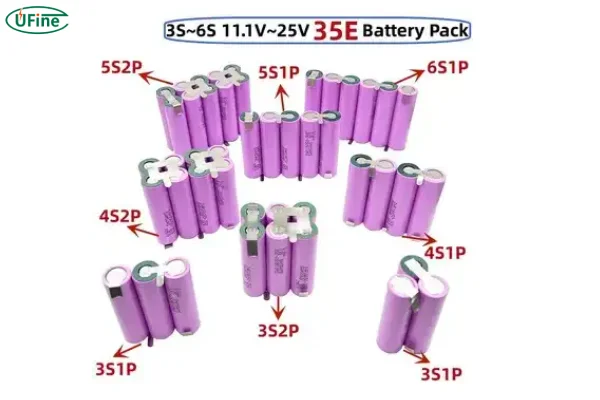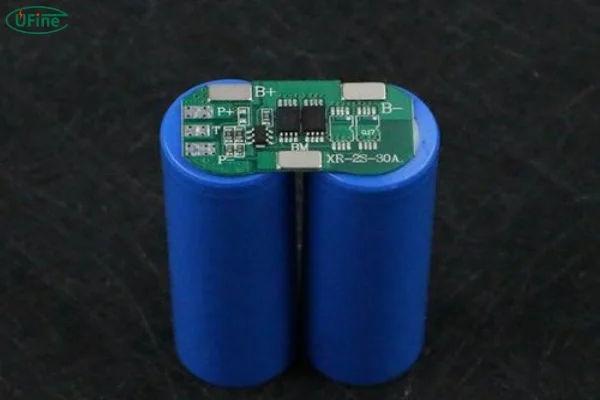LiPo batteries are a favorite among hobbyists and professionals alike for their high energy density and lightweight design. Whether you’re into RC cars, drones, or other gadgets, you’ve likely encountered the term “2S LiPo battery.” But what does “2S” mean, and why is it important? In this comprehensive guide, we’ll explore everything you need to know about 2S batteries, from their basic characteristics to how to choose the best one for your needs.
Part 1. What does 2S mean on a LiPo battery?

The “2S” in a 2S LiPo battery stands for “2 Series.” This indicates that the battery consists of two individual cells connected in series. In a series connection, the voltages of each cell add up while the capacity (mAh) remains the same. Each LiPo cell typically provides a nominal voltage of 3.7 volts. Therefore, a 2S battery combines these cells to deliver a nominal voltage of 7.4 volts.
Why Series Connection?
Series connections are used to increase the voltage of the battery pack without changing the capacity. This higher voltage is essential for devices that require more power to operate efficiently. It’s a common configuration in many applications, from RC vehicles to drones and portable electronics.
Part 2. What is the 2S battery voltage?
A single LiPo cell has a nominal voltage of 3.7 volts. When two cells are connected in series, their voltages combine. Thus, a 2S LiPo battery has a nominal voltage of 7.4 volts (3.7V + 3.7V). However, when fully charged, each cell can reach up to 4.2 volts, making the total voltage of a fully charged 2S battery 8.4. Conversely, the voltage can drop to 6.0 volts (3.0V per cell) when fully discharged.
Voltage Range
Understanding the voltage range is crucial for the safe operation of your devices. Operating outside this range can damage the battery or the device. Most electronic speed controllers (ESCs) and chargers are designed to handle this specific voltage range.
Part 3. 2S LiPo battery capacity
The capacity of a 2S LiPo battery is measured in milliampere-hours (mAh). This indicates how much charge the battery can hold and how long it can power your device. For example, a 2S LiPo battery with a capacity of 2000mAh can provide 2000 milliamps of current for one hour. The higher the capacity, the longer the run time.
-
500mAh – 1300mAh: These smaller capacity batteries are typically used in lightweight drones, RC cars, or small electronic projects. They are popular because they offer a good balance between size, weight, and runtime.
-
1500mAh – 2200mAh: Slightly higher capacity batteries are commonly used for medium-sized drones, RC vehicles, and general-purpose applications where you need more runtime without significantly increasing the weight.
-
3000mAh – 5000mAh: Larger capacity 2S LiPo batteries are used in high-power applications that require longer operation time, such as high-performance drones, airsoft guns, and larger RC models. These offer longer run times but come with a tradeoff in size and weight.
Choosing the Right Capacity
When selecting a battery, consider your device’s power requirements and the expected run time. Higher capacity batteries provide longer run times but are often heavier and larger. Balancing capacity with size and weight is key to optimizing performance.
Part 4. What C-Rate 2S LiPo battery should I use?
Understanding C-Rating
The C-rating is a measure of how quickly the battery can be discharged. For instance, a 2000mAh battery with a 20C rating can safely discharge at 40,000mA (2000mAh x 20C). High C-ratings are essential for applications that require bursts of high power, like racing drones or high-speed RC cars.
What is a High-Rate Discharge Battery?
For a 2S LiPo battery, the appropriate C-rate depends on the specific requirements of your application.
-
Low Power Devices: If you are using the battery in low-power applications such as small drones or lightweight RC vehicles, a 10C to 20C discharge rate may be sufficient. This means that for a 2000mAh 2S LiPo battery, it can safely discharge at 20A to 40A.
-
Medium Power Devices: For more demanding applications like mid-range drones, RC cars, or airsoft guns, you might need a 25C to 30C discharge rate. This would allow a 2200mAh 2S LiPo battery to discharge at 55A to 66A.
-
High Power Devices: High-performance drones, racing RC cars, or other high-power applications may require batteries with 40C to 60C or even higher discharge rates. A 2000mAh 2S LiPo battery with a 50C discharge rate can safely discharge at 100A, which is ideal for fast-paced, power-demanding activities.
Part 5. 2S LiPo battery key parameters
When shopping for a 2S LiPo battery, several key parameters can influence your decision:
- Voltage (V): A 2S battery has a nominal voltage of 7.4V.
- Capacity (mAh): Determines the battery’s run time.
- C-Rating: Indicates the discharge rate. A higher C-rating means the battery can deliver more current, which is crucial for high-performance applications.
- Size and Weight: Ensure the battery fits your device’s battery compartment.
- Connector Type: Ensure the battery’s connector is compatible with your device.
Part 6. How Long Does 2S LiPo Battery Last?
The lifespan of a 2S LiPo battery can be understood in two ways: run time per charge and the overall battery life.
-
Run Time per Charge: The run time of a 2S LiPo battery largely depends on its capacity, the current draw of the device, and the discharge rate (C-rate). As a general guideline:
- A 1000mAh 2S LiPo battery can last anywhere from 8 to 15 minutes in a drone or an RC car, depending on usage conditions.
- Larger batteries with higher capacities (e.g., 2200mAh or 3000mAh) can last up to 20-40 minutes under moderate use.
-
Battery Life (Cycle Life): The overall lifespan of a 2S LiPo battery is measured in charge cycles. On average, a LiPo battery can last for about 300-500 charge cycles before it begins to lose capacity and performance. Proper maintenance, such as avoiding overcharging, deep discharges, and excessive heat, can extend the lifespan of your battery.
Part 7. 2S LiPo battery charger
When choosing a charger for your 2S LiPo battery, it’s important to select one that is designed to handle LiPo batteries and has the capability to charge multiple cells safely. Here are the types of chargers you should consider:
-
LiPo Balance Charger: A balance charger is designed to safely charge each cell of the 2S LiPo battery (which has 2 cells in series). It ensures that both cells are charged equally, preventing overcharging or undercharging of individual cells, which can extend battery life and improve safety.
-
AC/DC LiPo Charger: These chargers work with both AC (wall outlet) and DC (car battery or other DC sources) power. They often come with multiple channels, allowing you to charge multiple batteries at once.
-
Smart Charger: Smart chargers are equipped with built-in safety features like overcharge protection, temperature monitoring, and automatic cutoffs when the battery is fully charged. They are an excellent choice for those looking for a more automated, safer charging process.
-
Charger Specifications: Make sure the charger provides a 4.2V per cell charge (a fully charged 2S LiPo battery should be at 8.4V). Also, ensure the charger supports the current output appropriate for your battery’s capacity. For example, a 1C charge rate for a 2000mAh battery would be 2A.
Part 8. Top 10 2S LiPo battery manufacturers
If you’re looking for reliable 2S LiPo batteries, consider these top manufacturers known for their quality and performance:
1. Ufine Battery
Ufine is a custom lithium battery manufacturer from China. Their product range includes lithium polymer batteries, 18650 batteries, LiFePo4 batteries, and lithium-ion battery packs. They are known for their consistent quality, long cycle life, and comprehensive safety features. The most important thing is that they can customize batteries of different sizes, capacities, and voltages according to customer needs. Contact us now to get a quote!
2. Turnigy:
Characteristics: Turnigy is a well-known brand for affordable, high-quality 2S LiPo batteries. They offer various capacities, discharge rates, and physical sizes to cater to various RC and hobby applications.
3. Tattu:
Characteristics: Tattu is known for its premium 2S LiPo batteries with high energy density, low internal resistance, and reliable performance. They prioritize safety and quality in their battery design.
4. Thunder Power
Characteristics: Thunder Power is a premium LiPo battery manufacturer focusing on high-performance, low-resistance cells. They are known for their attention to detail and advanced manufacturing processes.
5. Rhino
Characteristics: Rhino is a brand specializing in 2S LiPo batteries designed for heavy-duty applications. They offer rugged, high-discharge-rate batteries with excellent durability and safety features.
6. Multistar
Characteristics: Multistar is a brand owned by Hobbyking, known for its affordable and reliable 2S LiPo batteries. They provide a good balance of performance and value across various capacities and discharge rates.
7. Gens Ace
Characteristics: Gens Ace is a reputable manufacturer of high-quality 2S LiPo batteries. They are known for their exceptional performance, long cycle life, and comprehensive safety features.
8. Zippy
Characteristics: Zippy is a brand offering a wide range of 2S LiPo batteries, catering to budget-conscious and performance-oriented users. They provide a decent balance of price and quality.
9. Lectron Pro
Characteristics: Lectron Pro is a manufacturer known for its high-quality and high-performance 2S LiPo batteries. They focus on advanced cell chemistry, strict quality control, and innovative safety features.
10.MaxAmps
Characteristics: MaxAmps specializes in high-capacity, high-discharge-rate 2S LiPo batteries. They are known for their exceptional power delivery and extended runtime.
Related Tags:
More Articles

How to Choose the Best Floor Scrubber Battery for Commercial Cleaning?
Selecting the ideal floor scrubber battery ensures a long runtime, rapid charging, and minimal maintenance for efficient commercial cleaning operations.
Battery for Blower vs Battery for Leaf Vacuum: Which One Should You Choose?
Battery for blower vs leaf vacuum—learn the key differences in power, fit, and runtime to choose the right battery for your outdoor tool needs.
How to Choose the Right Battery for Blower?
Choosing the right blower battery? Consider voltage, capacity, chemistry & usage. This guide helps match the best battery for peak performance.
How to Choose the Best Insulated Battery Box for Lithium Batteries?
Choosing the Best Insulated Battery Box for Lithium Batteries? Discover key factors such as size, material, and safety for optimal protection and performance.
7 Critical Elements on a Lithium Battery Shipping Label
What must be on a lithium battery shipping label? Learn 7 key elements to ensure safety, legal compliance, and correct handling across all transport modes.







